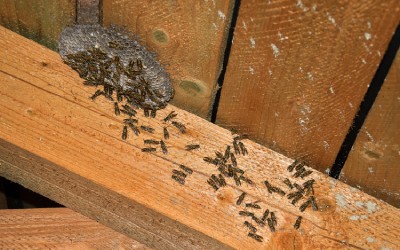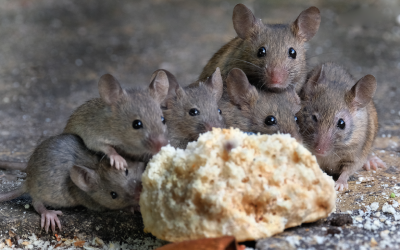Every year as the weather changes in the fall, many pests attempt to head somewhere warmer. Many of the insects that don’t die off in the fall take part in a phenomenon called overwintering. They find a habitable environment to wait out the cold winter months. Some insects will migrate to warmer clients, some find hiding spots outside under debris, while others try to get inside homes and buildings to stay warm.
Unfortunately for homeowners, the pests that try to overwinter inside warm buildings frequently end up in our homes. Often these pests will end up in low-traffic areas of homes like behind the walls or in the attic. The most frequent pests to watch for in the fall and winter include rodents, termites, stink bugs, Asian lady beetles, and wasps. Continue reading to learn more about these common fall pests and their efforts to get in your home.
Rodents
Many pests can get into your attic by climbing up onto the roof. Squirrels are the most well-known culprits, but roof rats and mice are jaso adept at climbing and making nests in the attic. How can you tell if you have rodents living in your home? The most common sign of a rodent infestation is scratching or gnawing sounds from above or from inside the walls; if you hear these sounds, it’s time to call an experienced rodent exterminator.
Termites
The cost of termite damage in the United States is estimated to be up to $30 billion annually – making them the most destructive pest in the country by dollar value. While termites are present all year, fall and winter can worsen an already-existing infestation. Like many insects, subterranean termites (the most destructive species) tend to burrow deeper into the ground to stay warm in the winter, when most of us spend less time outside. This combination means you’re less likely to discover a subterranean termite infestation until the spring.
Once termites get in your home, they’ll consume wood (the structure of your home) and anything else that contains cellulose. Signs you may have termites in your home include blisters on painted falls, hollow-sounding wood, mud tunnels in your crawlspace, and unexplained pinhole-sized holes.
Stink Bugs
Another common pest that often hides undetected during the winter, typically in attics, crawlspaces, or behind the walls, is the stink bug. Known for their shield-shaped backs and their mottled coloring of brown and gray, the most common species, the brown marmorated stink bug, ranges in size from about ¼” to ⅜”. As their name suggests, stink bugs release an unpleasant odor when they feel threatened or are squished.
Asian lady beetles
Asian lady beetles look very similar to ladybugs, but with a few differences: they tend to be a bit larger, and though their coloration is similarly reddish orange, they don’t all have spots. These insects can be found in groups and communicate with each other using pheromones – so if one lady beetle finds its way into your home, you’re likely to have a large infestation on your hands. Asian lady beetles do not pose any direct threat to your home’s structure and don’t bite or sting, but their waste can stan as well as trigger allergic reactions and breathing problems for individuals with sensitivities.
Wasps
Generally speaking, wasps die off before each winter and the colonies do not overwinter. But to keep the colony thriving the following year, the fertilized queens will find a warm hiding spot to overwinter, often in stumps or hollow logs outdoors, or in protected structures like crawlspaces and attics. This can often lead to wasp infestations the following year when the queens restart their colonies.
Expert Exterminators
If you have any of the pests on this list in or around your home in the Moore County NC area, Aberdeen Exterminating can help. We’ve been providing quality pest control services to Moore County since 1960. We can get rid of pests trying to overwinter in your home, or provide preventative services to help keep them from ever getting in. Contact us for a free quote!


